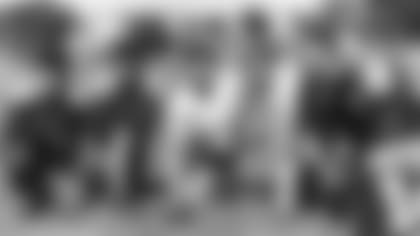Jeff from Monroe, WI
This may be too boring for some readers, but I hope you can shed some light on it. I know the Notre Dame Box was a variation of the single-wing in which the left halfback was the tailback or featured passer, the fullback the featured runner, the right halfback more of a blocker/receiver and the quarterback a blocking back. But I look at old Packers rosters and find contradictions. From 1929-31, Red Dunn was the quarterback and a primary passer. In the 1930s, Hank Bruder and Larry Craig were quarterbacks and blocking backs. Arnie Herber was listed as a right halfback, typically not a position to receive a snap. On later rosters, Cecil Isbell and Tony Canadeo were listed as left halfbacks and primary passers. I'm trying to understand how this offense worked. Thanks for any insight you can give.

Out of respect for the homework you've done, I'm going to run the risk of boring some readers, as you suggested I might, and provide an answer that's going to read like a thesis. Part of what contributes to the confusion about Curly Lambeau's offense is that you get mostly brief and stock summaries of it from people who haven't done sufficient research. Granted, I don't have all the answers, either. For starters, assorted rule changes over the years addressing the passing game, substitution, and pre-snap shifts and motion are virtually impossible to sort out. A 1946 column by Art Daley of the Green Bay Press-Gazette noted that the so-called shiftless Notre Dame Box that Lambeau was using at that point was almost solely his creation, but its roots were planted in Knute Rockne's original system where all four backs would simultaneously shift or motion before the snap. Clearly, it would be impossible at this point to thoroughly trace how the offense evolved and changed over the more than 25 years that Lambeau used it. But, hopefully, what I've been able to uncover will provide some of the information you're seeking. It comes from four primary sources. 1) Several Press-Gazette articles, mostly from the 1940s, that reviewed the history of Lambeau's offense, as well as bits and pieces from Stoney McGlynn's columns in the Milwaukee Sentinel. Having played college football for four years, McGlynn offered some rare insights into the Packers from the 1920s into the 1940s. 2) A story with diagrams written by Lambeau in 1945 and a letter written by Clarke Hinkle in 1973 that are on file at the Ralph Wilson Jr. Pro Football Research and Preservation Center in Canton, Ohio. 3) Several interviews I conducted 10 years ago or more with some of Lambeau's players from the 1930s and early '40s. 4) A study recently conducted by Packers stats expert Eric Goska of games played and starts by position for the nearly 20 backs from the Lambeau era inducted into the Packers Hall of Fame.
Lambeau learned the Box from Rockne when he played at Notre Dame in 1918 and employed it as coach of the Packers through 1946. While Lambeau's Box might have been similar to the single-wing, there also were distinct differences. The four backs typically formed a box-shaped backfield with a balanced line. The center snap was shorter. The left halfback was usually the featured passer, but he wasn't the focal point of the offense to the degree that single-wing tailbacks were. Instead, Lambeau sought versatility in all of his backs. As a result, many of his best were proficient runners, passers, kickers and receivers, and they could be used interchangeably at different positions. "Our best teams have been those with at least three better-than-average all-around men teamed up in one backfield," Lambeau said. Generally, before the backs shifted, the left halfback and fullback lined up deep and next to each other, 4½ to 5 yards behind the line of scrimmage. Both were in position to take the snap from center. The quarterback and right halfback were positioned in front of them, closer to the line of scrimmage. The quarterback would line up directly behind the center and shift right or left behind a guard. The right halfback was given more latitude. He'd usually stand directly behind the right end, outside the right end or in a slot position somewhere in between. Whatever the case, the strength of the offense, according to Lambeau, was its flexibility and the ease with which the four backs could shift left or right "without destroying their effectiveness or limiting the attack's deception." Finally, Lambeau's flexibility as a coach also was critical to the success of his Box. He clearly adapted to his personnel rather than force players to fit his system.

Here's maybe the best example of that. Lambeau ran a different variation of the Box when he won three straight NFL championships from 1929-31 with Red Dunn as his quarterback and featured passer than he did when he won his other three titles in 1936, '39 and '44 with Arnie Herber, Cecil Isbell and Irv Comp as his featured passers from the halfback positions. Dunn was the last of Lambeau's Box quarterbacks to call signals. He played what Lambeau called the T-slot. It was a position where Dunn could take a direct, short snap from center and also one Lambeau likened to a T-formation quarterback. While Dunn's greatest gift was his all-around ability, he also was unofficially the NFL's second-most prolific passer prior to 1932, or during the league's pre-stats era. Dunn was credited in The Football Encyclopedia, published in 1994, with 4,641 career passing yards. He also threw 24 touchdown passes during the Packers' first three championship seasons. All the while, NFL rules required that all passes be thrown from more than five yards behind the line of scrimmage. It wasn't until two years after Dunn retired that passes were legalized from anywhere behind the line. "Red Dunn could throw the ball as well as anybody at the time," teammate and Pro Football Hall of Famer Johnny Blood told author Ralph Hickok some 40 years after Dunn retired. "Benny Friedman was considered the best pro passer then, because he had the big college reputation, but every time we played the (New York) Giants, Red outplayed Benny as far as I'm concerned." Now let's fast forward to when Larry Craig was the Packers' quarterback from 1939-46. Craig never attempted a pass in those eight years -- or at any time in his 11-year career. In fact, he almost never touched the ball. In the years he played quarterback, Craig had 10 rushing attempts and caught 13 passes. Nicknamed Superman, he was someone opposing players didn't want to mess with. He was a fierce blocker on offense and a pass rushing terror on defense. Hall of Fame quarterback Sammy Baugh called him the best he ever played against. In 1946, when Lambeau picked his all-time Packers team, he chose both Dunn and Craig at quarterback. Hank Bruder, by the way, was the starting quarterback or blocking back when the Packers won the 1936 title and he didn't throw a single pass that season, either.
While Herber replaced Dunn as the primary passer in Green Bay's offense starting in 1932, he didn't play the same position. Herber might have been inducted into the Pro Football Hall of Fame as a quarterback, but he started only two games there, both in 1930, his rookie year. That was because Lambeau determined Herber wasn't capable of playing Dunn's old position, close to the line of scrimmage. Therefore, of Herber's 47 other starts with the Packers, 30 were at right halfback and 17 at left halfback. In theory, he really didn't fit Lambeau's basic requirements at those positions, either. Unlike most of Lambeau's other left halfbacks, Herber wasn't much of a runner. And in a standard Box formation, the right halfback lined up as close to the line of scrimmage as Dunn did at quarterback. Nonetheless, Lambeau found ways to utilize Herber's greatest strength: His ability to throw deep with deadly accuracy. I can't explain how Lambeau did it. I've got 17 pages of diagrams from 1941, the year Herber and the Packers parted ways, but none before that. So I can't tell you how Lambeau moved Herber around to ensure that he would be in position to throw the ball. But my hunch would be that there were several factors at play, starting with the versatility of Lambeau's other backs. For example, Bobby Monnett was a starting left halfback in 33 games from 1933-38 when Herber was in the prime of his career. Monnett wasn't a star, but he was good enough to be inducted into the Packers Hall of Fame. In the words of McGlynn, Monnett ran like a "South Dakota jackrabbit." Also, he was reliable on short field goals and extra points. And he could lob a soft, easy-to-catch pass. Thus, Monnett was the short passer and Herber threw mostly deep. At roughly the same time, Joe Laws played seven seasons with Herber. Both played right halfback and both called signals from there, but they were two entirely different players. Laws rushed 470 times and caught 79 passes during his 12-year career, but threw only 33 passes. Clearly, he played more like a traditional right halfback or a single-wing wingback. Herber, on the other hand, was the NFL's all-time passing leader when Lambeau cut him five days before the 1941 opener, but averaged 0.8 yards in 201 rushing attempts and caught merely 11 passes in his 11 seasons in Green Bay. Things also changed for Herber when Isbell came on the scene in 1938. Isbell played mostly left halfback and led the Packers in both passing and rushing as a rookie. One year into Isbell's career, Bears coach George Halas declared him a better player than Herber. Still, a year later when the Packers won their fifth NFL title under Lambeau, Isbell led them in rushing again, but Herber threw for more yards. Based on Hinkle's letter, Isbell and Herber shared the left halfback position in 1939. But game summaries show Herber starting seven games at right halfback. Perhaps Lambeau mixed and matched his backs, and used pre-snap shifts and different formations to put Herber in position to take the snap even as a right halfback, but that's based strictly on two scant clues. One was this quote from Lambeau: "In some systems a triple-threat right halfback would be wasted." But not in his offense, Lambeau insinuated. Also, a diagram of Don Hutson's first NFL touchdown, an 83-yard pass that beat the Chicago Bears in 1935, showed Herber lined up directly behind the center as the left halfback in position to take the snap with the fullback and quarterback in front of him and to each side. Blood, the right halfback, was split wide, outside the right end. As the play unfolded, the backfield didn't at all resemble a box. Unfortunately, there's no longer any way of getting answers to some of these specific questions. There are no more survivors who played in Lambeau's Box. That said, I think it's revealing that Lambeau didn't put Herber on his all-time team.

What about some of Lambeau's other backs? Blood played on the Packers' first four NFL championship teams (1929-31, '36) and had his biggest impact as a receiver. But of his 31 starts, 15 were at right halfback, 11 at left halfback and five at quarterback. In terms of versatility, he might have been the quintessential back of his day. He also was Lambeau's choice at right halfback on his all-time team. Hinkle, another Pro Football Hall of Famer, played fullback from 1932-41 and retired as the NFL's all-time leading rusher. Lambeau said he wanted his fullbacks "fast and rugged," and Hinkle was all of that, but he also was a threat to pass and punt from that position. Prior to Hinkle, Bo Molenda was the usual starter at fullback when the Packers won their first three titles. At left halfback, Lambeau picked two players on his all-time team: Verne Lewellen and Isbell. Again, both were outstanding all-around backs. Lewellen was almost universally regarded as the best punter over the first 25 years of the NFL, if not the first 50 years, and probably was the most valuable player on at least the Packers' first two championship teams. Based on how teammates reacted when he wasn't one of the first Packers elected to the Pro Football Hall of Fame and how newspapers in New York, Chicago and other cities singled him out for being the difference-maker as the Packers went 11-3 against the Bears and Giants en route to winning their first three titles, one has to wonder if Lewellen shouldn't be in the discussion for greatest Packer ever. Lewellen scored more touchdowns than anyone in the NFL at a time when teams averaged fewer than 10 points per game. Based on The Football Encyclopedia's unofficial statistics from 1920-32, the NFL's pre-stats era, Lewellen also ranked as one of the NFL's two leading rushers, sixth leading receiver and 12th leading passer. But it was his punting that allowed the Packers to consistently dominate field position and win big games. Let's use the 1928 season as an example. Lewellen punted 136 times in 13 games – again, according to unofficial statistics – whereas Packers kicker Harry O'Boyle led the NFL with three field goals. In 1929 and '30, when the Packers won their first two championships, Lewellen was credited with 85 and 89 punts, respectively. That's what made Lewellen so valuable. Games centered on him, much the same as they do with today's quarterbacks. He could boom punts from his own side of the 50 and mastered the coffin-corner punt at a time when teams eschewed kicking field goals even inside their opponents' 45-yard line. "No one who ever saw Lewellen kick could ever forget him," Arthur Daley, who covered countless NFL games during his career with The New York Times from 1926-76 and the first sportswriter to win a Pulitzer Prize, wrote in 1962. "He was the finest punter these eyes ever saw." If you're still looking for more perspective on Lewellen's 136-punt year, Tim Masthay punted 81 times last season. Isbell, on the other hand, put up record-setting numbers as a passer once Herber was gone, but retired after only five seasons to go into coaching. When Isbell retired he had better stats and was more decorated on all-pro teams than Baugh, who had entered the NFL one year earlier.

As for the pre-Dunn years, Charlie Mathys was the Packers' quarterback from 1922-26, and Lambeau must have used him in a different role than either Dunn or Craig. Mathys left his mark primarily as a receiver. According to The Pro Football Chronicle, he unofficially led all NFL players in the 1920s in pass receptions. That said, Mathys also threw 11 TD passes. But Lambeau, who played all five seasons with Mathys, was the team's star and featured passer, mostly from the right halfback position. Of Lambeau's 49 NFL starts, 35 were at right halfback, seven at quarterback, six at fullback and one at left halfback. In 1943, after Isbell retired, Tony Canadeo took over as the left halfback, but was a much better runner than passer and eventually evolved into a T-formation halfback. In 1944, Canadeo went into the service and Comp played left halfback and led the league in passing yards as the Packers won their final NFL title under Lambeau. In 1947, Lambeau switched to the V- or Wing-T formation, which he referred to as a variant of his old, Dunn-led Notre Dame Box.
Just a few final notes. I've yet to find where Lambeau used the term tailback – or wingback – in reference to any player or position in his offense. Ditto for his players. Even in diagrams, Lambeau used the initials, LH and RH, rather than TB and WB. Lambeau claimed the Packers "were the first club … which made the forward pass their basic attack," and also differed from their opponents in that they were the first team to "pass on first, second, third or fourth down … regardless of our position on the field." Accordingly, he considered the Notre Dame Box to be the offense best suited for his passing game. Yet his two offensive ends normally lined up a yard outside the tackles and that included Hutson. That's not to say Hutson didn't split out, but he usually played tighter to the tackle than the tight end in Vince Lombardi's power sweep. Rules limiting substitution forced players to play offense and defense so Lambeau's backs were also expected to be sure tacklers. Lambeau said his general rule was to spend the first five to eight minutes of a game feeling out the opposition. Presumably, that was at least partly why he didn't always start his No. 1 unit. For example, Hutson started only 60 of 116 games during his career. Part of the deception of Lambeau's offense was the spinning by the backs. "The left halfback or the fullback would be in a straight line, so the center could snap the ball to either one," said John Biolo, who played guard for the Packers in 1939 and was later a Hall of Fame coach at Green Bay West High School. "The fullback lined up behind the center and on the shift, he'd go between the guard and the tackle on that side of the line. They'd pass it back to the fullback and he'd take a step forward and spin around and hand the ball to the left halfback or fake to the left halfback and run through the line or run the weak-side play with the guards pulling." It wasn't unusual for the Packers to quick kick for much of the Lambeau era, which helps explain why punters got so many opportunities. In 1935, for example, Goska found that the Packers punted 52 times on first, second or third down, and 47 times on fourth down with two punts unaccounted for. Moreover, punting and placekicking were shared duties, presumably because of limits on substitution. For example, in 1938, the Packers used six placekickers. In 1940, they used five punters, including Hinkle, Herber and Isbell.
*Photos courtesy of Green Bay Packers Hall of Fame, Inc. archives.
*
For more of Cliff Christl's historical perspectives, click here.* *















